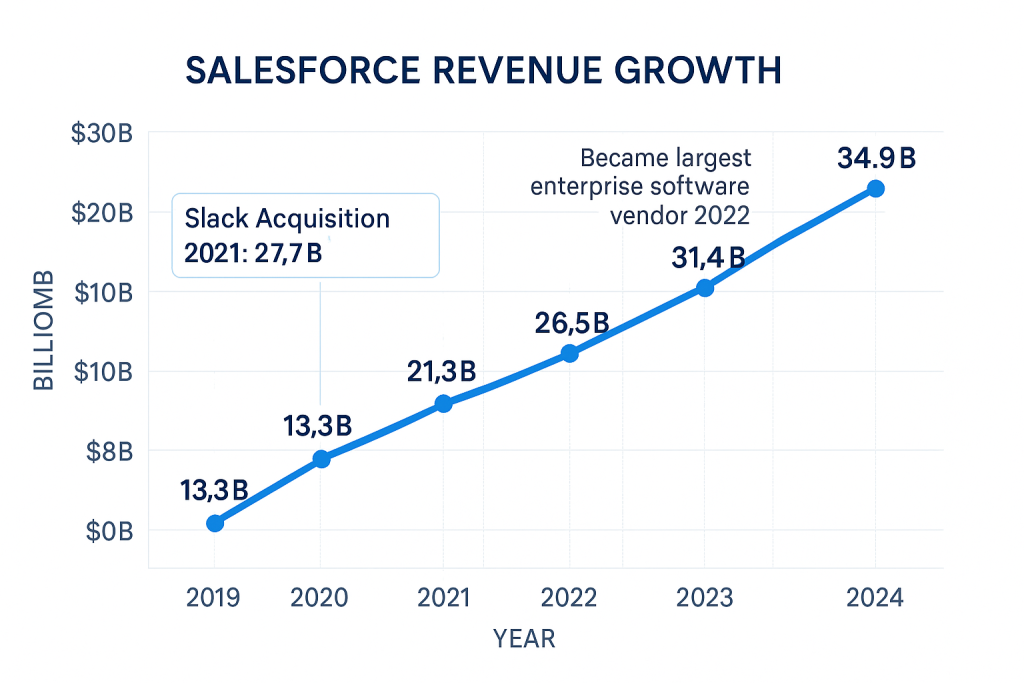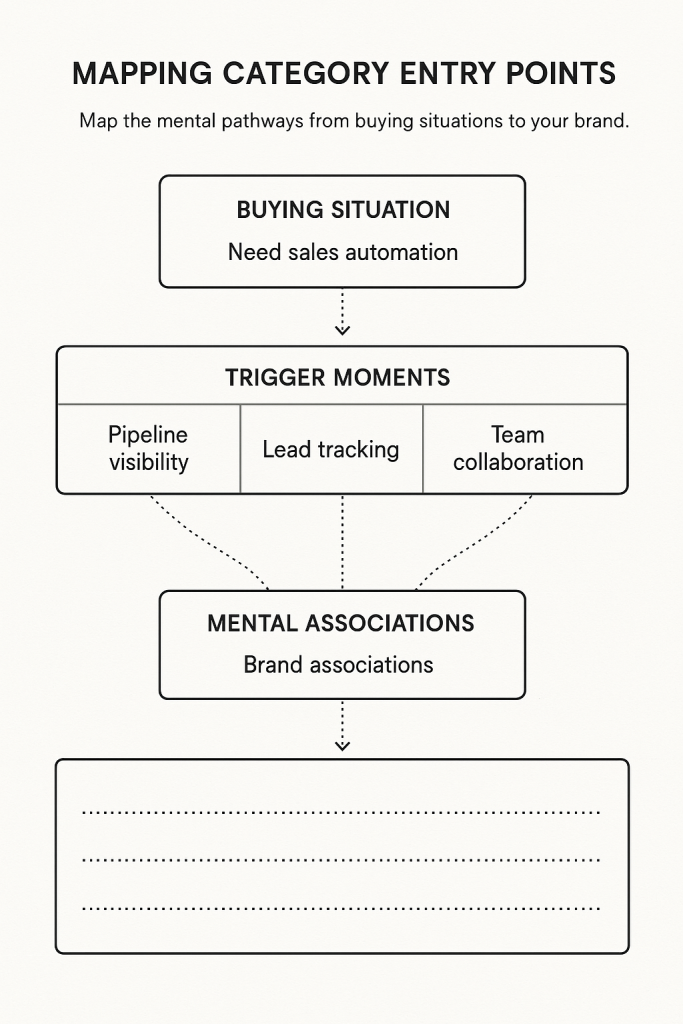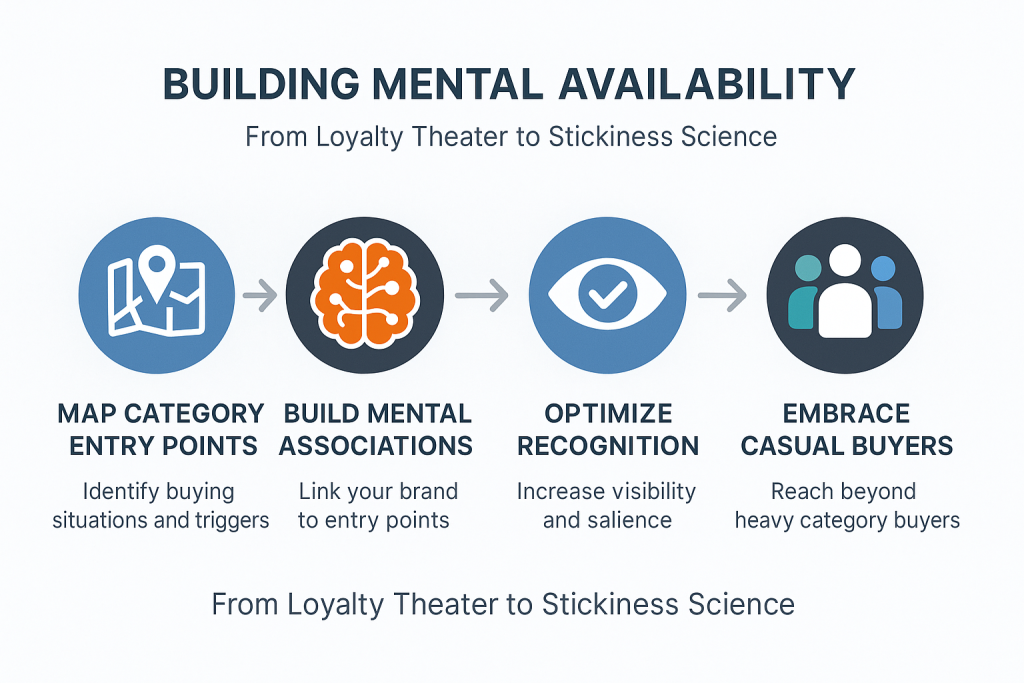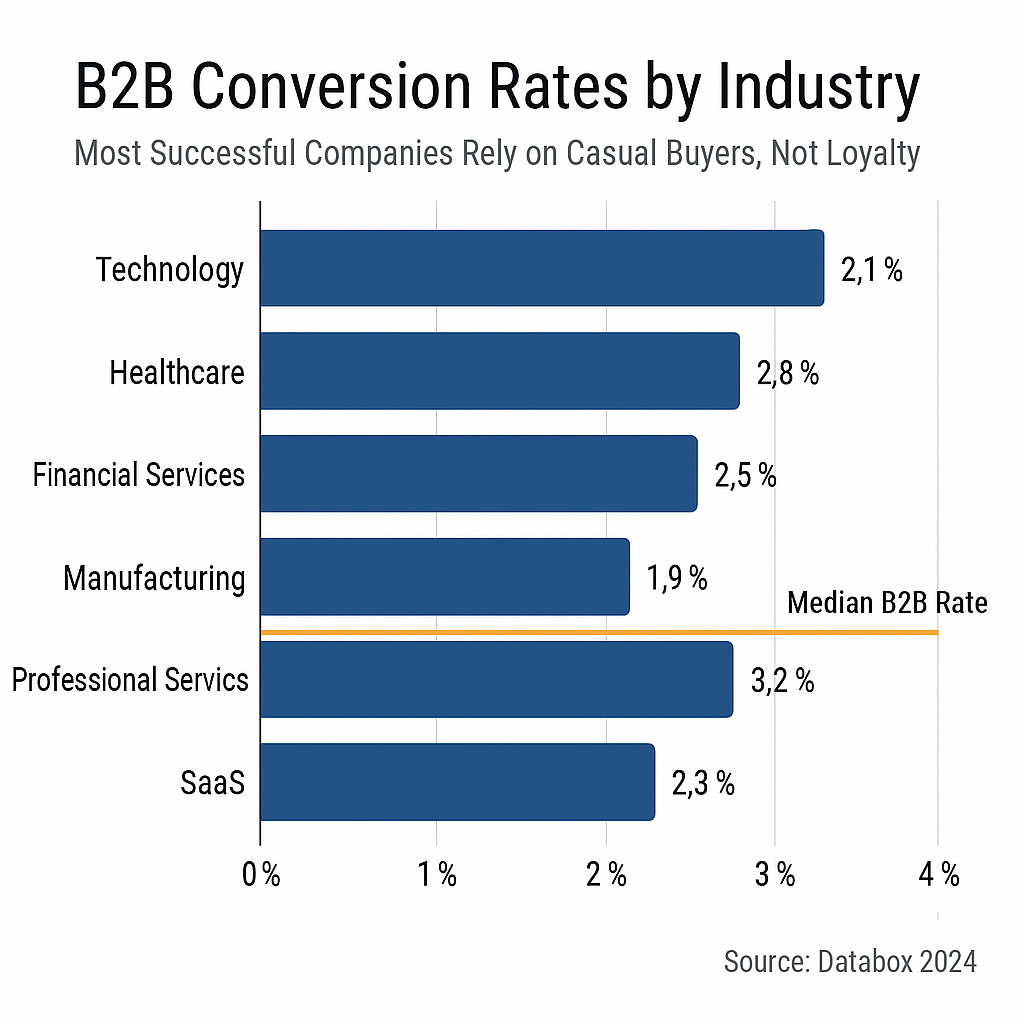Reading Time: 12 minutes | Last Updated: September 2025
Bottom Line Up Front: The brand stickiness vs brand loyalty debate reveals a crucial truth: while B2B tech leaders chase the loyalty unicorn, the real money lies in brand stickiness. Salesforce didn’t build a $34.9 billion empire through passionate brand evangelists—they mastered mental availability with a cartoon mascot named Astro.
Table of Contents
Meet The Expert: Dr. Ethan Decker on Brand Science
The insights in this article come from an exclusive interview with Dr. Ethan Decker, founder and president of Applied Brand Science and one of the world’s leading experts in brand growth science.

Decker’s unique background combines rigorous scientific training with two decades of practical marketing experience. He earned a PhD in ecology and complexity theory from the University of New Mexico under a National Science Foundation grant, studying urban ecosystems and computational modeling. His academic papers continue to be cited in scientific literature today.
After transitioning from academia, Decker spent 20 years creating award-winning brand strategies for some of the world’s biggest companies, including roles as Planning Director at 72andSunny and Group Strategy Director at Crispin Porter Bogusky. He’s worked with major brands like Duracell, Domino’s, Hotels.com, and La-Z-Boy, applying scientific rigor to marketing challenges.
His approach—the Laws & Levers of Brand Science—cuts through marketing fads and “zombie ideas” to focus on empirically-proven principles of brand growth. As both a scientist by training and marketer by trade, Decker represents “the missing link between science and creativity” in the marketing world.
Watch the full interview where these insights were shared:
The loyalty myth is killing your growth strategy.
Here’s what most C-suite executives get wrong about building billion-dollar brands: they’re obsessing over creating passionate loyalists when they should be focusing on becoming sticky enough to stick around in buyers’ leaky brains.
The brand stickiness vs brand loyalty distinction isn’t just academic—it’s the difference between sustainable growth and chasing vanity metrics. After working with nonprofits, SaaS companies, and digital agencies, I’ve witnessed this fatal assumption repeatedly. Marketing teams burn through budgets chasing emotional connections, yet their prospects often can’t recall the company name when it’s time to buy.
This misalignment between strategy and reality is exactly why developing a clear thought leadership strategy becomes critical—not to build passionate fans, but to achieve consistent mental availability.
The $31 Billion Reality Check That Destroys Loyalty Myths
Salesforce generated $34.9 billion in revenue in 2024.
Not through passionate brand lovers. Through mental availability.
As Ethan Decker, brand science expert and founder of Applied Brand Science, puts it: “Brand love is great, but it’s not where the money’s at. Brand friends is where the money’s at. It’s good to have a thousand fans. But a thousand fans, first of all never exist without a hundred thousand very casual brand buyers.”
Think about your own buying behavior.
Even the people who love Levi’s jeans don’t wear Levi’s underwear, shirts, or belts. Even Apple “loyalists” don’t buy Apple headphones, computer mice, or speakers exclusively.
The data backs this up. Even Salesforce, with its stellar reputation, converts less than 5% of its traffic into qualified leads. Industry benchmarks show B2B conversion rates typically range from 1.1% to 2.4%, with top performers achieving 5.31% or higher.
This isn’t failure. This is physics.
Key Statistic: Research from Databox shows the median session conversion rate across B2B businesses was 2.3% in November 2023, proving that even successful companies rely on casual buyers, not passionate loyalists.

Brand Stickiness: The Appropriately Imprecise Goal That Actually Works
“I think brand stickiness is a great goal, and I’ve used that term sticky a lot these days because it’s appropriately imprecise,” Decker explains.
Brand stickiness measures how likely customers are to think of you when they have a buying moment. Not how much they love you. How easily you come to mind.
Here’s the difference:
Brand Loyalty: Emotional connection, passionate advocacy, exclusive purchasing Brand Stickiness: Mental availability, consistent choice, practical preference
Loyalty requires deep emotional investment. Stickiness requires showing up consistently when buyers are making decisions.
Which is easier to achieve at scale? Which drives more revenue?
In my experience ghostwriting educational email courses for funded B2B tech startups, the companies that obsess over NPS scores and brand sentiment often struggle with pipeline generation. Meanwhile, those focused on category entry points and mental availability consistently hit growth targets.
Understanding this difference is crucial for driving sustainable B2B sales growth in today’s competitive landscape.
Definition Box: Mental availability refers to how easily a brand comes to mind when buyers encounter a purchase situation in the category. It’s measured by the strength and quantity of memory associations between the brand and various purchase triggers.

How Salesforce Cracked The Mental Availability Code
Salesforce didn’t achieve market dominance through passionate CRM enthusiasts.
They mastered the art of being sticky in a dry, technical category.
They created Astro—”a little character, a little person, usually in a squirrel suit sometimes in an astronaut suit”—that “puts a fun, nice, cute, warm face to this otherwise dry, stale corporate brand in a dry, stale corporate category.”

As Decker notes: “The global head of brand for Salesforce said, if you had asked me if I should pin my hopes and my career to a small furry animal in B2B, I would’ve thought you were crazy. But the data suggests it’s worked.”
This isn’t about mascots. This is about mental availability.
Salesforce understood that B2B buyers “are trying to find their keys and they’re trying to remember which appointment they have to go to this afternoon. They are not really thinking about you and they’re not really caring deeply about you.”
So they made themselves impossible to forget.
This strategic approach to brand building differs significantly from traditional social media growth strategies that focus on engagement metrics rather than mental availability.
The Tourist Economy Truth Your Competitors Don’t Understand
Most B2B tech companies operate in what Decker calls a “tourist economy”—where buyers rarely return and reputation spreads slowly.
In a tourist economy, “people come off of the Caribbean cruise ship and they have to buy trinkets and they have to go to restaurants. Those places they’ll never see those tourists again usually… And the tourists rarely have enough info to know which is the good restaurant and which is the bad.”
This describes most B2B software purchases perfectly.
Buyers evaluate solutions once every few years. They have limited information. They want something good enough, not perfect.
They don’t need to know every detail about you. “They just need to think of you a little bit.”
The Banana Curve Reality That Destroys Loyalty Fantasies
Here’s the empirical evidence that loyalty-focused strategies miss the mark:
Every business with 50+ customers follows what’s called the “banana curve distribution.”
You have “a lot of light buyers, very few medium buyers, and almost no heavy buyers. It’s a banana curve. It slopes very quickly off.”

Even billion-dollar companies like Salesforce have mostly light users. Most people who own Apple products own just one. The people who think Apple has incredible loyalty and brand love are the ones who own three or four Apple products, but even they have other brands of headphones, computer mice, and speakers.
This reality breaks the loyalty myth.
The goal isn’t “to get people that have 20 seats on your subscription for email service or CRM… to then hire you for 2000 seats. The company isn’t growing that quickly, or the company is stable, or the company is shrinking.”
Much more valuable: acquiring an additional 20 companies as light buyers.
Voice Search Optimization: When business leaders ask “How did Salesforce build their brand?” the answer isn’t loyalty—it’s mental availability through consistent brand presence and distinctive assets like Astro.
Why The Wells Fargo Cross-Sell Dream Became A Nightmare
Want proof that loyalty obsession leads to disaster?
Wells Fargo claimed they could get banking customers to buy six, seven, or eight products through “incredible cross-sell” and customer loyalty programs.
It turned out they were setting up fraudulent accounts because, as Decker explains, “just from the laws of brand growth and cross sell, you could predict that they were cheating, that they were frauds because they were doing things that defied the laws of brand physics.”
When C-suite leaders chase loyalty metrics that defy brand physics, bad things happen.
Teams feel pressure to hit impossible targets. Marketing budgets often get wasted on emotional campaigns that fail to drive the pipeline. Growth stalls as competitors, who focus on mental availability, pull ahead.
This is why understanding the science behind effective lead generation on LinkedIn becomes crucial—it’s built on behavioral psychology, not loyalty fantasies.
The Mental Availability Framework That Actually Builds Brands
Here’s how to shift from loyalty theater to stickiness science:
1. Map Your Category Entry Points
Category Entry Points are “the Mental Pathways linking the buying situation and the brand.” What triggers buying moments in your space?
For CRM software: “automate sales communications,” “improve pipeline visibility,” “track lead progression”
For cybersecurity: “prevent data breaches,” “compliance requirements,” “incident response”

2. Build Consistent Mental Associations
Mental availability means “ensuring that your brand is readily accessible in the minds of potential buyers at the moment they are making a purchase decision.”
This requires showing up consistently around your category entry points. Not just during campaigns. All the time.
3. Optimize For Recognition, Not Recall
Brand stickiness comes from doing “anything to help people like your brand a little bit.” When it’s time to choose, “you might come to mind a little easier. And then also you might get the benefit of the doubt.”
Make your brand easier to recognize than remember.
4. Embrace The Casual Buyer
Stop trying to convert light buyers into heavy buyers. Instead, focus on getting “another 20 companies. Some of those will be small, some of those will be large.”

Actionable Takeaway: List your top 5 category entry points, then audit where your brand appears during those buying moments. This gap analysis reveals your biggest mental availability opportunities.
The Revenue Math That Proves Stickiness Wins
Let me share what I’ve observed working with B2B tech startups from seed to Series C:
Companies obsessing over loyalty typically see:
- High NPS scores from small customer segments
- Low pipeline velocity
- Narrow market penetration
- Revenue concentration risk
Companies optimizing for stickiness typically achieve:
- Broader market awareness
- Consistent pipeline generation
- Diversified revenue streams
- Sustainable growth rates

Current data shows the median session conversion rate across B2B businesses was 2.3% in November 2023, but companies focused on mental availability consistently outperform these benchmarks.
How To Build A Sticky Brand Without A $27 Billion Slack Budget
Salesforce could afford to buy Slack for $27.7 billion. You probably can’t.
But you can apply their mental availability principles:
Create Distinctive Brand Assets
Your visual identity should be instantly recognizable. Applied Brand Science uses “a lot of orange” and “an orange frog with elk antlers” so “if you look for applied brand science and do an image search, it’s a sea of orange.”
Develop Sticky Messaging
B2B companies are “terrible” at this. “All they think about are the specs, the facts. They wanna be precise and they don’t think about being sticky.”
Think “quicker picker upper” for Bounty. What’s your equivalent?
Show Up Consistently
Decker explains his approach: “I post a fair bit of content. I engage in conversations, I write articles, I appear on podcasts and shows, and that gets people thinking about applied brand science a little bit before they might be in the market.”
The LinkedIn Content Strategy That Builds Mental Availability
As someone who ghostwrites LinkedIn content for C-suite leaders of B2B tech companies, I’ve seen which approaches build mental availability versus vanity metrics.
Posts that build stickiness:
- Share contrarian industry insights
- Reference recognizable frameworks
- Use consistent visual branding
- Address specific buying moments
Posts that chase loyalty:
- Generic thought leadership
- Company culture content
- Product feature announcements
- Achievement celebrations
The difference? Sticky content helps prospects think of you during buying moments. Loyalty content makes existing fans feel good.
Which drives more pipeline?
This approach differs from typical social media facts and trends that focus on engagement rather than business outcomes.
Why Digital PR Beats Brand PR For Mental Availability
Traditional brand PR aims for emotional connection. Digital PR builds mental availability through strategic link placement and content distribution.
When prospects research solutions, they encounter your brand in contexts that suggest authority and relevance. This creates mental associations between your company and their buying moments.
That’s stickiness at scale.
The Educational Email Course Secret Weapon
One of the most effective stickiness tactics I’ve deployed for funded B2B tech clients: educational email courses that map to category entry points.
Instead of nurturing “leads,” these courses build mental availability. When prospects eventually have buying moments, your brand is already associated with solving their problems.
This approach consistently outperforms traditional loyalty-focused nurture campaigns in my experience with cleantech and environmental services companies.
The Measurement Framework That Matters
Stop tracking loyalty theater metrics. Start measuring mental availability:
Instead of NPS, track:
- Unaided brand awareness in your category
- Share of search for category terms
- Recognition rates for your distinctive assets
Instead of engagement rates, track:
- Category entry point associations
- Buying moment mentions
- Solution consideration inclusion
Instead of advocacy scores, track:
- Mental market share
- Category penetration rates
- Competitive displacement frequency

As Decker recommends: “You gotta go talk to and listen to the light buyers and the non-buyers and the people you don’t hear from often.”
This analytical approach should inform your overall digital marketing strategy and content distribution efforts.
The Contrarian Truth About B2B Brand Building
Here’s what the data tells us about building brands that actually drive revenue:
Most successful B2B companies have lots of casual buyers, not passionate loyalists. Big brands have “higher frequency” and more customers who “stick around more, they buy more on average, they churn a little bit less” because “penetration rate, the number of customers you have is very correlated with your purchase frequency.”
It’s not about finding your 1,000 true fans. It’s about being good enough for 100,000 casual buyers.
This isn’t a consolation prize. This is physics.
The Ehrenberg-Bass Institute has extensively documented these patterns across industries and geographies.
Why Your Ghost Writer Should Understand Brand Science
Most B2B content focuses on thought leadership and product education. This builds expertise but not mental availability.
Content that builds stickiness requires understanding category entry points, buying moments, and mental associations. It requires systematic exposure during the long periods when prospects aren’t actively buying.
That’s why my approach to ghostwriting educational content differs from traditional marketing agencies. Instead of just creating “valuable content,” I build systematic mental availability through strategic content placement and category entry point mapping.
This strategic content approach enables B2B companies to achieve predictable growth, rather than relying on viral content moments.
The Path Forward: From Loyalty Theater To Stickiness Science
Stop chasing the loyalty unicorn. Start building brand stickiness.
This week:
- Map your category entry points
- Audit your distinctive brand assets
- Identify your casual buyer segments
This month:
- Test recognition-based messaging
- Launch consistent content distribution
- Track mental availability metrics
This quarter:
- Build systematic category presence
- Develop sticky brand frameworks
- Optimize for buying moments
The companies that crack mental availability will dominate their categories. Those who chase loyalty will wonder why their “brand lovers” don’t translate to revenue growth.
Salesforce built a $34.9 billion empire by understanding this distinction. Their secret wasn’t creating passionate CRM evangelists—it was becoming impossible to forget when buying moments arrived.
Your prospects aren’t looking for brands to love. They’re looking for solutions that come to mind when problems need solving.
Be that solution.
FAQ: Brand Stickiness vs Brand Loyalty
What’s the difference between brand stickiness and brand loyalty?
Brand stickiness measures how likely customers are to think of your brand during buying moments, while brand loyalty focuses on emotional connection and repeat purchasing behavior. Stickiness is about mental availability; loyalty is about passionate advocacy.
Why doesn’t brand loyalty work anymore in B2B?
Research shows that most successful B2B companies follow a “banana curve” distribution with many light buyers and few heavy buyers. Even “loyal” customers typically use multiple brands and switch based on convenience, not emotion.
How did Salesforce use mental availability to grow revenue?
Salesforce created distinctive brand assets (like their Astro mascot) and maintained a consistent presence across category entry points. They made themselves easy to remember in a dry, technical category without relying on passionate brand evangelists.
What are category entry points in B2B marketing?
Category entry points are the mental pathways that link buying situations to brands. For example, “automate sales communications” or “improve pipeline visibility” are category entry points for CRM software.
How do you measure brand stickiness versus loyalty?
Instead of NPS scores, track unaided brand awareness, share of search for category terms, and recognition rates for distinctive assets. Focus on mental market share rather than advocacy scores.
Can small B2B companies build brand stickiness without huge budgets?
Yes. Focus on distinctive visual assets, consistent messaging, and showing up consistently around your category entry points through content marketing and strategic distribution, rather than expensive advertising campaigns.
Want to build mental availability through systematic content distribution? My digital PR and ghostwriting services help B2B tech companies build stickiness through strategic category entry point mapping and educational content deployment. Let’s explore ways to make your brand unforgettable during key buying moments.
Related Resources
Explore more insights on B2B growth and marketing strategy:
Articles:
- B2B Sales Growth Trends And Strategies: Driving Revenue in 2025 – Discover proven strategies to boost your revenue with data-driven tactics for sustainable B2B growth.
- Thought Leadership Strategy: A Step by Step Guide For Growth – Learn how to build a thought leadership strategy that increases brand awareness, authority, and trust.
- How to Boost Lead Generation on LinkedIn With Neuroscience Tweaks – Discover how scientifically proven neuroscience approaches can boost your LinkedIn lead generation.
- How to Craft a Brand Awareness Strategy to Drive Growth – Learn key tactics, metrics, and best practices backed by data and expert insights.
Podcast Episodes:
- How to Create a Successful B2B Podcast That Drives Business Growth – Learn how to create content that builds mental availability rather than just engagement.
- How to Use Trade Show Marketing Strategies to Fuel Business Growth – Discover how to prioritize brand awareness versus lead generation in your marketing strategy.
- The Predictable B2B Success Podcast – Weekly insights from experts on building systematic growth through strategic brand building.
Related Links – Connect with Dr. Ethan Decker
Learn more about brand science and mental availability:
- Applied Brand Science Website – Ethan’s company offering brand strategy, training, and keynotes on the science of brand growth.
- LinkedIn: Ethan Decker – Follow Ethan for regular insights on brand science, marketing research, and advertising effectiveness.
- Instagram: @appliedbrandscience – Visual content and behind-the-scenes insights from Applied Brand Science.
- Twitter: @ehdecker – Ethan’s thoughts on marketing science and brand growth research.
- Ethan’s TED Talk – Watch Ethan’s highly-rated TED Talk on brand signals and consumer behavior.
Note: Ethan is currently developing books, courses, and workbooks on brand science. Follow his channels above for updates on new publications.
Sources:
- Applied Brand Science podcast interview with Ethan Decker
- Salesforce Statistics 2025: Revenue reached $34.9 billion for fiscal year 2024
- First Page Sage B2B Conversion Rate Study 2025
- Unbounce Conversion Benchmark Report
- Databox B2B Marketing Benchmarks 2024
Some areas we explore in this episode include:
Listen to the episode.
Subscribe to & Review the Predictable B2B Success Podcast
Thanks for tuning into this week’s Predictable B2B Podcast episode! If the information from our interviews has helped your business journey, please visit Apple Podcasts, subscribe to the show, and leave us an honest review.
Your reviews and feedback will not only help me continue to deliver great, helpful content but also help me reach even more amazing founders and executives like you!

